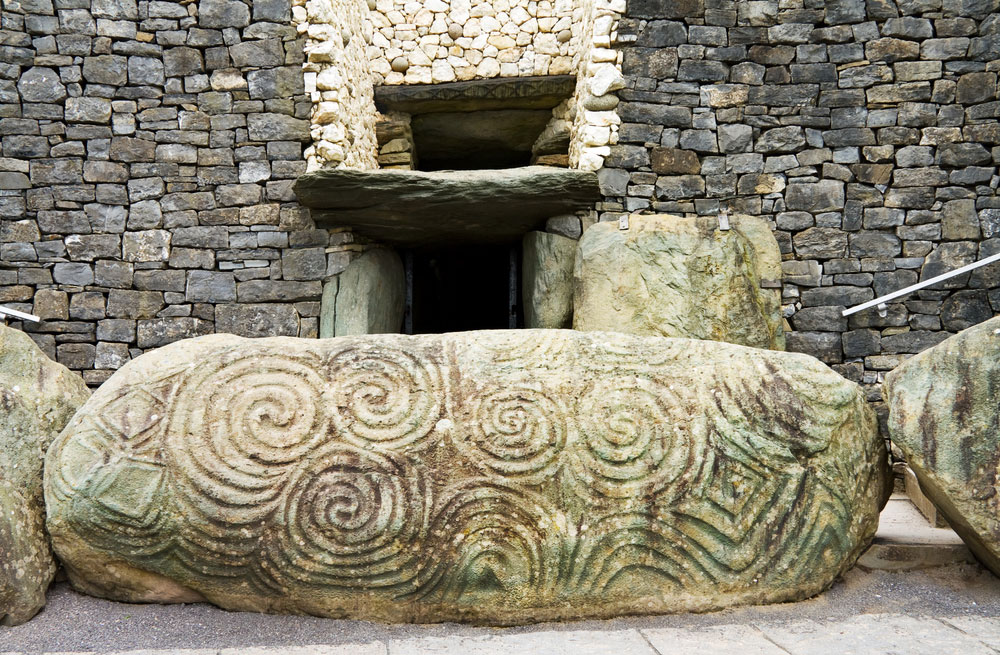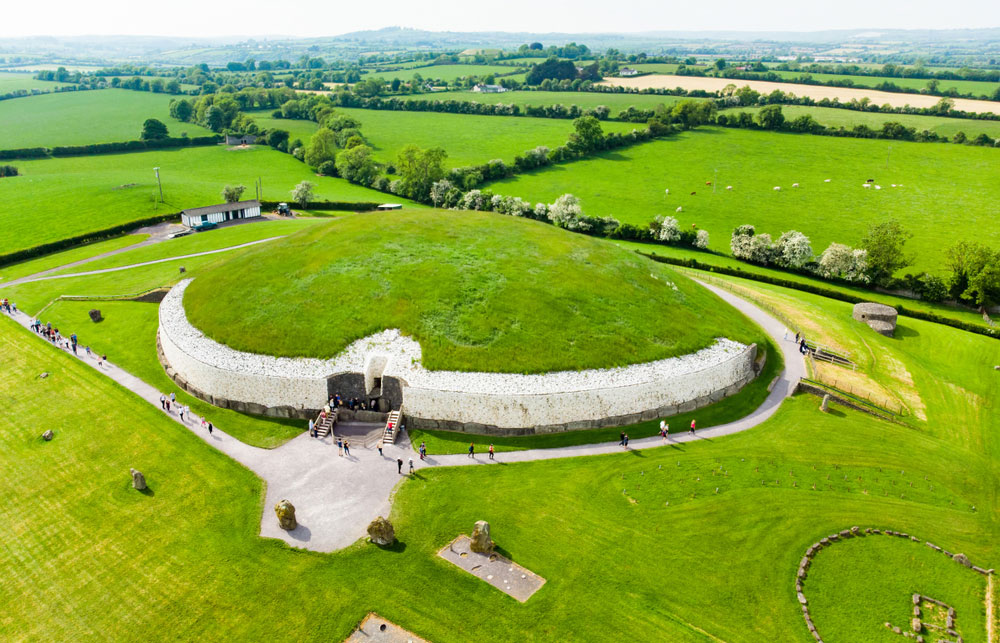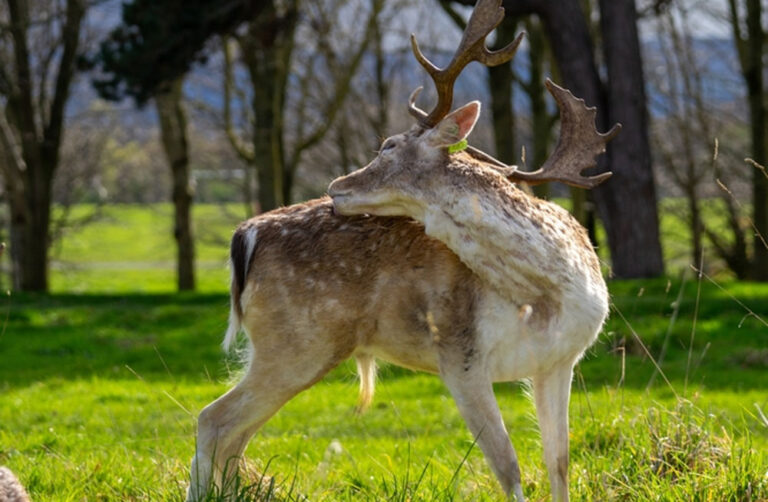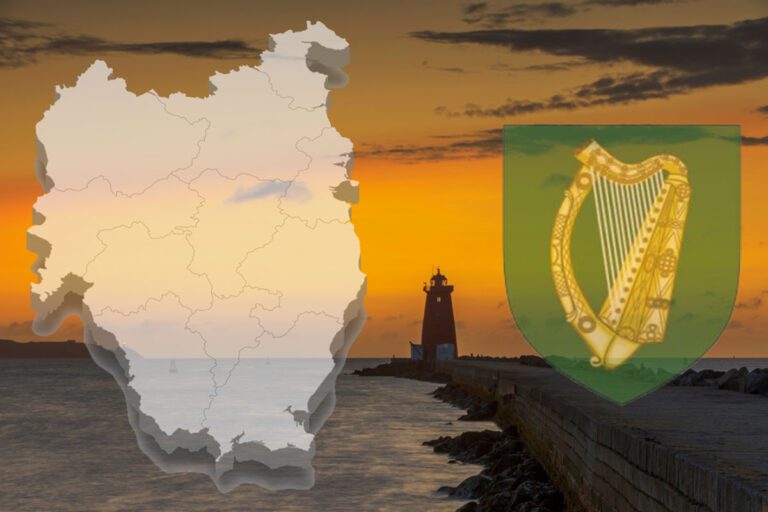The Origins of Newgrange
Newgrange’s history dates back over 5,000 years to the Neolithic period, often known as the New Stone Age. Ireland was mostly covered with woods at the time, and the people who lived there were talented farmers and craftspeople who relied on the land for a living.
Newgrange was built circa 3200 BC, making it one of the world’s earliest megalithic buildings. It was constructed on a hill overlooking the Boyne River, and its circular shape and alignment with the sun indicate that it was used for religious and ceremonial reasons.
The monument is a massive circular stone and earthen mound, or cairn. The cairn is 85 meters in circumference and 13.5 meters high, with 97 huge standing stones known as kerbstones surrounding it. The kerbstones are intricately adorned with megalithic art, such as spirals, lozenges, and triangles.
A corridor at the cairn’s core connects to a succession of rooms. The 19-meter-long corridor is lined with big stone slabs. The passageway’s rooms are cruciform in design, with a central chamber and three smaller chambers branching off from it. The chamber walls are also adorned with megalithic art, including spirals, circles, and zigzags.
Newgrange is said to have been used for a number of functions, including burials for significant members of the society and religious and ceremonial meetings. The monument’s position with the rising sun on the winter solstice implies that it may have had special importance in respect to the seasonal cycle and the passage of time.
Newgrange fell into decay and was mostly forgotten over time. It wasn’t rediscovered by local landowners until the 17th century, and it wasn’t until the 1960s that major restoration work began. Nowadays, Newgrange is acknowledged as one of Ireland’s most important archaeological sites, with thousands of visitors visiting each year.
Megalithic Artwork
Megalithic art is a type of ancient art seen in a variety of megalithic buildings, notably Newgrange. It is distinguished by the use of abstract symbols and patterns carved or etched on stones.
Newgrange’s megalithic art is among the best and most ornate in the world. It’s thought to have been made by the same people who built the tomb, and it reveals much about their beliefs, values, and way of life.
The triple spiral on the entrance stone is one of the most prominent examples of megalithic art in Newgrange. The triple spiral is made up of three interlocking spirals that are carved into the stone clockwise. The exact meaning of this symbol is unknown, however it is said to have religious or spiritual significance. Some believe it signifies the cycle of life, death, and rebirth, while others believe it represents the three elements of earth, water, and sky.
Lozenges, triangles, zigzags, and circles are among the other types of megalithic art found in Newgrange. These symbols are frequently discovered together, and they are assumed to have been utilized to represent complex meanings and concepts. The zigzag design, for example, may have signified lightning or water, but the circle could have represented the sun or the moon.
Newgrange’s megalithic art is notable for its richness and sophistication. The carvings and engravings are very intricate and exact, and they exhibit a true command of the material. They also provide essential information about the culture and beliefs of the people who erected Newgrange, and they continue to captivate and inspire visitors to this day.

Preservation and Restoration
Newgrange is a one-of-a-kind and precious archaeological gem that must be maintained for future generations to appreciate and enjoy. Weathering, erosion, and human activity have all posed challenges to the monument throughout the years. A variety of repair and preservation projects have been done to safeguard the property.
In the 1970s, one of the most substantial restoration efforts at Newgrange was completed. The monument was in ruin at the time, with many of the stones loose and unstable. A team of professionals was recruited to do a thorough restoration that included reconstructing the cairn, stabilizing the stones, and fixing the damaged regions.
A number of other preservation and restoration work have been conducted at Newgrange since then. These efforts have included measures to avoid future erosion and damage to the site, as well as initiatives to educate tourists on the significance of maintaining this historic landmark.
Guided tours to Newgrange have grown in popularity in recent years. These tours allow visitors to learn about the site’s history and significance, as well as to witness the extraordinary megalithic art and engineering that went into its construction.
In addition to the repair and preservation work done at Newgrange, efforts have been made to preserve the site against current dangers. For example, the entrance to the tomb is limited to a certain number of people every day, and precautions have been taken to protect it from weather, pollution, and other environmental elements.
Newgrange’s repair and preservation are critical to ensure that this amazing monument continues to inspire and captivate people for years to come. The efforts to save the site emphasize the importance of conserving our cultural history, as well as our continued dedication to understanding and appreciating the past.
Going to Newgrange
Visiting Newgrange is a remarkable and one-of-a-kind experience that should not be missed if you are interested in history and archaeology. The location is in County Meath, approximately 50 kilometers north of Dublin, and is easily accessible by vehicle or public transit.
Visitors can have a guided tour of the site upon arrival, which includes a visit to the interior of the tomb. The tour instructors are knowledgeable about Newgrange’s history and significance, as well as the engineering and craftsmanship that went into its creation.
The ability to visit the tomb and view the megalithic art up close is one of the tour’s attractions. The tomb’s inside is unexpectedly vast, with finely carved stones and the iconic triple spiral sign on the entry stone.
Apart from the guided tours, there are a variety of additional attractions and activities in the neighborhood. Tourists may visit Drogheda, a neighbouring town with a rich history and a lot of noteworthy attractions. Visitors may also take a boat cruise on the Boyne River, which offers an unusual view on the terrain and surrounding region.
It is worth mentioning that, due to the popularity of Newgrange, prior reservations are strongly advised. The facility has a restricted amount of visitors, and tickets might sell out rapidly during high season. Visitors should also be advised that entry to the tomb’s interior is limited to those physically capable of climbing the steep stairway, and that minors under the age of 12 are not permitted.
Finally, a visit to Newgrange is an opportunity to travel back in time and marvel at one of the world’s oldest and most spectacular constructions. It is a must-see location for anybody visiting Ireland, with its interesting history, gorgeous architecture, and spectacular megalithic sculpture.
Here are some more famous tourist attractions in County Meath:
- Hill of Tara – an ancient ceremonial and political site with stunning views of the surrounding countryside
- Trim Castle – one of the largest Anglo-Norman castles in Ireland and a filming location for the movie “Braveheart”
- Kells High Crosses – a collection of 9th-century high crosses and other religious artifacts in the town of Kells
- Loughcrew Cairns – a series of Neolithic passage tombs and standing stones located on a hilltop with panoramic views
- Slane Castle – a grand castle with a rich history that is now used as a concert venue
- Bective Abbey – a 12th-century Cistercian monastery with impressive ruins and a beautiful riverside location.
Helpful Resources: Meath Tourist Website




